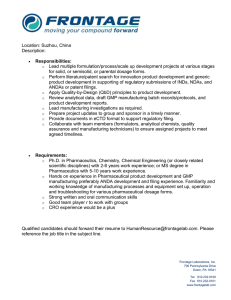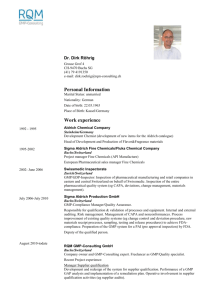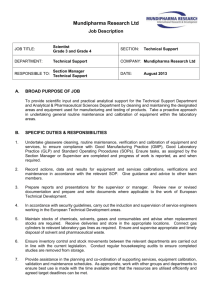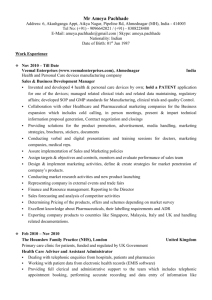Overview
advertisement
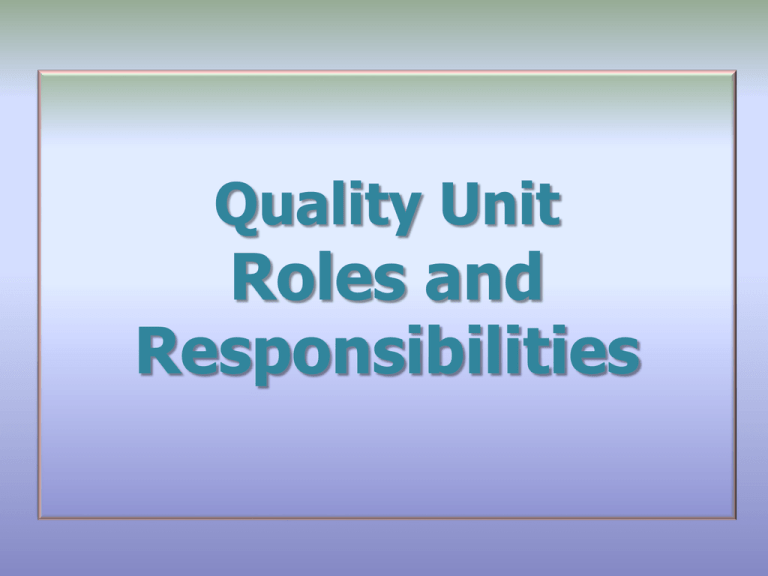
Quality Unit Roles and Responsibilities Overview • • • • • Directive Statement and Scope Glossary Responsibilities The Requirements What cannot be delegated Typical responsibilities for QA Typical responsibilities for QC Typical responsibilities for Regulatory QA (RQA) 1. Directive Statement • There must be in place both Quality Assurance (QA) and Quality Control (QC) functions in a defined and approved organizational structure. • The organization must be independent from manufacturing and must ensure that the manufacture and distribution of all products comply with the requirements of Good Manufacturing Practices (GMP), Good Distribution Practices (GDP), regulatory requirements and the requirements described in Company policies and procedures. 1. Directive Statement • Depending upon the size and complexity of the site, the Quality Assurance (QA) and Quality Control (QC) functions may operate as one unit. Approved organgrams indicating QA and QC Independence from manufacturing unit QA/QC: overall responsibility for quality QA/QC can operate as one unit 2. Scope • This training applies to manufacturing sites, affiliates (including distribution centres) and subcontractors • This is a broad scope which encompasses regulatory requirements and audits 3. Glossary (1) • Quality Unit : The term used to describe the all encompassing roles and responsibilities of the Quality Assurance and Quality Control departments • Quality Assurance Unit : That portion of the Quality Unit that sets policies, procedures and specifications, audits, reviews, assessments, provides training and is responsible for the approval or rejection of active pharmaceutical ingredients (APIs) and pharmaceutical (drug) product. It works in concert with, and as a check on the Quality Control Unit • Quality Control Unit : That part of the Quality Unit that is responsible for the ongoing control of quality within the company. It is responsible for the acceptance, quarantining or rejection of incoming raw materials and packaging components, conducting inprocess tests, labelling and inspection. 3. Glossary (2) • Quality Assurance (QA) : A system of activities designed to ensure that product quality, safety, purity and efficacy is known and effectively controlled. • The system includes a continuous evaluation of the adequacy and effectiveness of the overall Quality program. Corrective and preventive measures initiated as necessary. • For a specific product or service, this involves verification through audits, and the evaluation of the quality factors that affect the specification, production, inspection and use of the product or service. • Quality Control (QC) : That part of GMP, which is concerned with assessing and measuring specific and predefined Quality attributes Quality Assurance - Part of the Quality Unit 4. Responsibilities (1) Head of Site or Managing Director • approves the appointment of a Head of Quality at site • endorses any major change to the site Quality department organization Senior Site Management • is responsible for ensuring that there are systems and procedures in place to comply with Pharmaceutical Directives Site Management • is responsible for implementing the Quality System at the site. 4. Responsibilities (2) Site Management • must allow Quality Unit independence and the necessary objectivity required, to fulfil its responsibilities The Head of Quality • ensures that product manufacturing and distribution are in compliance with GMPs and GDPs; company policies and procedures; and applicable regulatory requirements The Site Quality Unit • defines, implements, manages, and controls all Quality systems. Responsibilities of the Quality Control Unit in US according to the CFR 211 • There shall be a QCU that shall have the responsibility and authority to approve or reject all drug components, APIs, etc • To review production records that no errors have occurred, or if errors have occurred, that they have been fully investigated • Adequate lab facilities for testing and approval shall be available • The QCU shall have the responsibility for approving or rejecting all procedures or specifications impacting product quality • The responsibilities and procedures applicable to the QCU shall be in writing; such written procedures shall be followed. 5. Requirements (1) • Head of Quality must report directly to Senior Site Management • Head of Quality must report functionally to the Head of site/Managing Director • Site Management must ensure that the Quality Unit is adequately staffed with associates having the necessary education, training, and experience to perform the assigned functions. Clear and defined reporting lines 5. Requirements (2) • Senior Site Management must provide adequate laboratory facilities to test the following: incoming components; inprocess materials; packaging materials; active pharmaceutical ingredients (API) or pharmaceutical (drug) products produced at the site. • Each Quality Unit must have people or units responsible for Quality Assurance and Quality Control. The major responsibilities of each area are outlined on the next slide. 5. Requirements (3) • Where the local regulations require that a Qualified Person (QP) be appointed, this person should be a part of the Quality Unit. • When this is not the case, then Quality Assurance must perform ultimate Batch Release. The duties of the Qualified Person(s) are described on the next slide. Duties of the Qualified Person(s) • The duties of the Qualified Person(s) are fully described in Article 51 of Directive 2001/83/EC, and can be summarised as follows : (a) for medicinal products manufactured within the European Community, a Qualified Person must ensure that each batch has been produced and tested/checked in accordance with the directives and the marketing authorisation (2) ; (b) for medicinal products manufactured outside the European Community, a Qualified Person must ensure that each imported batch has undergone, in the importing country, the testing specified in paragraph 1 (b) of Article 51 ; (c) a Qualified Person must certify in a register or equivalent document, as operations are carried out and before any release, that each production batch satisfies the provisions of Article 51. (From EU GMP Guide Part I, Chapter 2) 5. Requirements (4) • Site Quality Management must be structured in a way that the requirements of company policies and procedures are satisfied. • The size and complexity of the site will determine how the functions will be structured within the Quality Unit • The Quality Unit must be involved in all quality related matters. But do not forget : Quality should be the responsibility of all persons involved in manufacturing ! 5. Requirements (5) • The responsibilities of the Quality Unit must not be delegated and must include such activities as : • Final decision on acceptance for use or rejection of all materials, Active Pharmaceutical Ingredients (APIs), API Intermediates, package components, printed packaging materials, in-process materials, and pharmaceutical products (i.e. drug products) • Verification of Site compliance with Good Manufacturing Practices (GMPs) and Good Distribution Practices (GDPs), as applicable • Ensure that training programs at the site are managed according to company policy and regulatory requirements. 5. Requirements (6) • Management and monitoring of stability programs for marketed and distributed products • Review and approval of master manufacturing and laboratory control documents to assure adherence to registration, company Directives, GMPs, GDPs and qualification/validation protocol and reports • Review and approval of changes that potentially impact active pharmaceutical ingredients (APIs), pharmaceutical product and/or medical device quality (change control management) • Review and approval of sub-contractor work, (e.g., balance calibration, HVAC qualification, room qualification, testing equipment calibration, pest control reports, testing laboratories and their reports, etc.) 5. Requirements (7) • Maintenance and management of testing facilities to assure that raw materials, intermediates, active pharmaceutical ingredients (APIs), packaging materials, in-process materials and pharmaceutical products meet their specifications, including approval of all testing methods • Conduct internal audits of affiliates, facilities, operations and procedures to assure conformance with GMPs, GDPs and related regulatory requirements • Qualification, approval and audit of sub-contractors, contract testing laboratories and component suppliers to assure they can supply product or services that meet established requirements • Quality Management must be aware of, and ensure through audits, the approved status of suppliers of APIs and other Key Materials and Components used • Quality Management is responsible for the approval of Quality Agreements. 5. Requirements (8) • Ensuring that deviations are, documented, investigated, resolved and trended • Ensuring that effective systems are used for maintaining and calibrating critical equipment and instrumentation • Issuing written reports to the appropriate levels of management documenting instances of non-compliance to standard practices and requirements such as stability failures, product specifications, GMPs and GDPs • Monitoring progress on quality related corrective and preventive actions to assure timely compliance • Working with site operations to identify root causes to problems and opportunities for quality system improvements. 5. Requirements (9) • Ensure compliance of products with registration dossier requirements (“Regulatory Compliance”) • Ensure that monitoring, reintroduction and distribution of returned nondefective products into the market is managed and controlled • Preparation, organization and monitoring of Regulatory or Health Authority inspections • Additional responsibilities of the Quality Unit organization mandated by government regulatory agencies include: approval of specifications, product recalls, product complaint handling, anomaly handling, investigation management, archive and record retention, and implementation of selfinspections 5.1 Typical Responsibilities of QA (1) • • • Quality systems and management / continuous improvement Recalls or stock recovery Regulatory compliance • • • Self-Inspection (internal audit) External audits/GMP and GDP compliance Management of regulatory audits and inspections • • Management of controlled documents, e.g. SOPs, master documentation Qualification/Validation protocols and reports approval (equipment, process, cleaning, computerized systems, utilities, environmental, quality systems) • • Management of sub-contractors Management and monitoring of distribution centres 5.1 Typical Responsibilities of QA (2) • Complaint investigation and product recall coordination • Quality Agreement evaluation and approval • Annual Product Review (APR) for pharmaceutical product (i.e. drug product) and for finished products of the Chemistry organization (API’s and intermediates) • Management of change control evaluation • Deviations and failure investigations • Batch rework/ reprocessing approval • Release or rejection of intermediate materials for external use • Batch release or rejection for APIs and pharmaceutical products • Quarantine system 5.1 Typical Responsibilities of QA (3) • Training programs (e.g. GMP, GDP) • Supplier or vendor audits, qualification and approval • Stability program • Maintenance and calibration program approval • Master documentation review and approval • Product or batch documentation review and approval • Specification approval • Quality Steering Committee coordination • Quality communications and regulatory awareness • Technology transfer approval 5.1 Typical Responsibilities of QA (4) • Customer country interface for label text control • Storage and distribution systems • Implementation of Quality policies and procedures • Key Performance Indicator (KPI) reporting • Capital investment and project recommendations, assessments and reviews for all quality relevant matters • Disposition of returned goods • Record retention and archives 5.2 Typical Responsibilities of QC (1) • Sampling plans and retained sample management • Chemical, microbiological, biological, and physical testing/ batch analysis • Out of Specification (OOS) result investigations and trending • Specification approval • Release of raw materials, packaging components, inprocess materials • Approval of in-process controls • Calibration verification of QC equipment 5.2 Typical Responsibilities of QC (2) • Management of reference standards • Qualification of QC equipment • Stability program, controls and testing • Complaint analysis • Testing of validation samples • Contribution to raw material supplier approval • Assistance in audits of contract labs • Quality Agreement evaluation 5.2 Typical Responsibilities of QC (3) • Annual Product Review (APR) data compilation • Pharmacopoeia reviews • Supplier testing approval • Statistical Process Control (SPC) / Statistical Quality Control (SQC) • Environmental monitoring • Global specification standardization • Analytical Development either as part of QC or separate organizational unit (e.g. method development, method validation, specification generation, method transfer, new QC technologies Pharmacopoeia review, troubleshooting) 5.3 Site Documentation Review & Approval (1) • The Quality Unit has responsibility for review and approval of all documents which have GMP impact. These documents may need to be reviewed and approved in every instance, as they are produced, or on a regularly pre-defined (in an SOP) schedule • There are 2 types of document : Documents which require review and approval in every instance (Examples will be shown on the following slides) Documents that must be reviewed and approved on a predefined schedule, or as produced (Examples will be shown on the following slides) 5.3 Site Documentation Review & Approval (2) • Documents which require review and approval in every instance should include, and are not restricted to: • Standard Operating Procedures (SOPs), Analytical methods, inprocess controls and specifications Master manufacturing and laboratory control documents (for example ; Master formulae, Master Batch Records (MBRs), Analytical records etc. Internal and external audit reports, supplier Quality Agreements Qualification/validation protocols and reports 5.3 Site Documentation Review & Approval (3) • Documents which require review and approval in every instance (cont) : Annual Product Review Change control, deviation and failure investigations o GMP training programs o Engineering drawings of GMP areas o Sub-contractor work and reports (for example ; balance calibration, HVAC qualification, room qualification, pest control reports 5.3 Site Documentation Review & Approval (4) • Documents which require review and approval in every instance (cont) : • Final review and approval of completed batch dossier documents (batch production or manufacturing records, product control records and batch packaging records, analytical records) prior to the release of a batch or lot of product and, as required, to issue Certificates of Analysis (COA). o For APIs, batch manufacturing records for critical steps must be reviewed and approved by the Quality unit ; o Other steps may be delegated to Production for review and approval. 5.3 Site Documentation Review & Approval (5) • Documents that must be reviewed and approved on a pre-defined schedule, or as produced, should include, and are not restricted to: Graphs/cycles of any equipment or areas (including, temperature, humidity records etc.) Logbooks and record sheets (Equipment, shift handover, alert and alarm, pressure differentials, temperature records, cleaning etc.) Captured computer data of equipment or areas (maintenance, temperature records, pressure differential records etc.) 5.4 Site Documentation Review & Approval (6) Documents that must be reviewed and approved on a pre-definedschedule, or as produced: (cont) Site Master File Preparation of Technical Dossiers [Part 2/ Chemistry Manufacturing Control (CMC)] Registration changes CMC change control regulatory evaluation Master Certificate of Analysis Product license compliance audits Technical transfer document interface Thank You Any Questions

